/Vehicles/Axis/Germany/01-lePanzers/PzKpfw1/File/2-Design.htm | Last Up-date:
Panzerkampfwagen II Light Tank
Design
Le blindage du Panzer II qui au départ était au maximum épais de 13 mm était insuffisant pour tenir un rôle de char de combat. En effet il n'offrait une protection efficace seulement contre les armes légères et les éclats. Par après le blindage sera sans cesse augmenté pour atteindre sur certains modèles 80 mm d'épaisseur (ce qui est appréciable), ce qui nécessita des changements de moteurs et de suspension pour maintenir une mobilité suffisante. Le blindage fut amélioré pour répondre au danger des projectiles antichars à charge creuse. Un complément de blindage sera donc installé par superposition de plaques avec un intervalle entre elles et le blindage principal pour neutraliser une grande partie des effets dévastateurs des nouveaux projectiles. Néanmoins en général le blindage du Panzer II resta tout à fait insuffisant tout au long de la production. Les premiers modèles avaient un nez arrondi qui sera remplacé par deux plaques inclinées (formant un angle de 70°).
The shielding of Panzer II which at the beginning was to the maximum thick of 13 mm, was insufficient to hold a role of battle tank. Indeed it did not offer an effective protection only against the light weapons and the glares. By after the shielding will be unceasingly increased to reach on certain models 80 mm thickness (what is appreciable), which required changes of engines and suspension to maintain a sufficient mobility. The shielding was improved to answer the danger of the anti-tank projectiles with hollow-charge. A complement of shielding will thus be installed by superposition of plates with an interval between them and the principal shielding to neutralize most of the devastators effects of the new projectiles. Nevertheless in general the shielding of Panzer II remained completely insufficient throughout the production. The first models had a round nose which will be replaced by two tilted plates (forming an angle of 70°).
 |
Panzer II superstructure
and turret |
src:Connaissance de l'Histoire (Hachette) -
N°17 - " Les chars de combat allemands 39-45"
|
Le canon de 20 mm KwK 30/38 L/55 à tir automatique qui pouvait être une arme dévastatrice contre des objectifs légers était dès le départ surclassé par la plupart des armes montés sur les chars alliés. On pensa un moment, après la campagne de France de réarmer le Panzer II avec le canon français de 37 mm SA 38 mais l'idée ne fut menée à terme. C'est le modèle KwK 30 (basé sur le 20 mm Flak 30 antiaérien) qui fut monté sur les Panzers II a1 à F. Cette arme avait une cadence maximum de 280 coups par minute, ce qui est impressionnant, mais le panzer II ne transportait en général que 180 obus de 20 mm (10 magasins)! Le canon de 20 mm était couplé à une mitrailleuse de 7.92 mm MG 34 (provision de 2250 coups dans 17 cartouchières) montée à sa droite sur un bouclier interne, sur une tourelle monté sur la gauche. Le matériel optique était de type TZF4 et varia selon le modèle. Au départ le commandant ne disposait que d'une simple trappe sur le toit de la tourelle qui sera remplacée rapidement par une coupole de commandant. Certains Panzers II seront équipés de lance-grenade fumigènes de 90 mm sur les côtés de la tourelle.
The gun of 20 mm KwK 30/38 L/55 with automatic shooting which could be a destroy weapon counters light objectives upon the departure was outclassed by the majority of the weapons mounted on the allied tanks. One thought one moment, after the campaign of France to rearm Panzer II with the French gun of 37 mm SA 38 but the idea was not realized. It is the model KwK 30 (based out of the 20 mm anti-aircraft Flak 30) which was assembled on Panzers II a1 to F. This weapon had a maximum rate of 280 rounds per minute, which is impressive, but the panzer II in general transported only 180 shells of 20 mm (10 boxes)! The gun of 20 mm was coupled with a machine-gun of 7.92 mm MG 34 (provision of 2250 rounds in 17 cartridge pouches) mounted on its right on an internal shield, on a turret assembled on the left. The optical material was of type TZF4 and varied according to the model. At the beginning the commander had only one simple trap door on the roof of the turret which will be replaced quickly by a cupola of commander. Certains Panzers II will be equipped with smoke-producing lance-grenade of 90 mm on the sides of the turret.
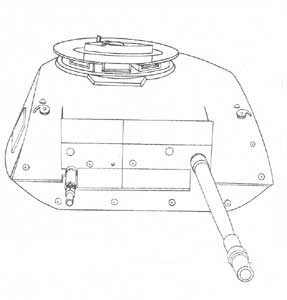 |
 |
Panzer II Ausf.F turret |
Turret development |
src:Connaissance de l'Histoire
(Hachette) - N°17 - " Les chars de combat allemands 39-45" |
Panzer II - Horst
Scheibert, Schiffer Military History |
20
mm KwK 30/38 L/55 Penetration of a shielding plate (mm) under a plunging angle of 30° |
|||||||
Ammo |
Weight |
Velocity |
100
m |
500 m |
1000
m |
1500 m |
2000
m |
| PzGr 39 | 0.148 kg |
780 m/s |
20 |
14 |
9 |
- |
- |
| PzGr 40 | 0.1 kg |
1050 m/s |
49 |
20 |
- |
- |
- |
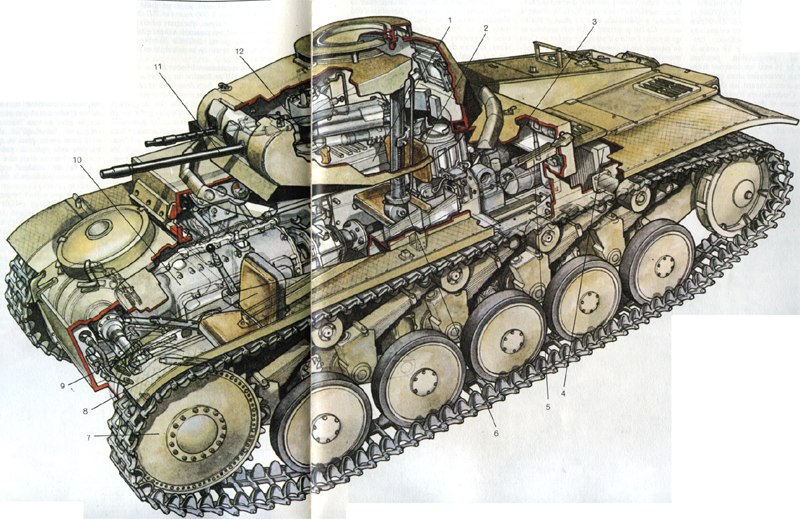 |
src: Hachette
|
L'équipage était composé du commandant-tireur et le chargeur dans la tourelle, ainsi que le pilote assis à l'avant du compartiment de combat, sur la gauche. Le commandant disposait d'un siège attaché à la tourelle alors que la chargeur restait debout sur le plancher. Fait amusant, la communication entre le commandant et le pilote s'effectuait via un simple tube. Pour les communications externes, le Panzer II disposait d'un poste radio FUG 5 USW (10 W). Le poste de pilotage sur les premiers modèles faisait saillie, il fut par la suite remplacé par une plaque frontale parcourant toute la largeur de la superstructure. Des sabords de vision et de tir étaient disposés un peu partout sur le pourtour du compartiment de combat et de la tourelle. Le commandant disposait également au départ pour sa vision d'un périscope dont on voit le capuchon sur l'avant de la tourelle. Par après il sera remplacé par des épiscopes avec l'installation de la coupole de commandant.
The crew was composed of the commander-gunner and the loader in the turret, as well as the pilot sitting in front of the compartment of combat, on the left. The commander had a seat attached to the turret whereas the loader remained upright on the floor. Amusing fact, the communication between the commander and the pilot was carried out via a simple tube. For the external communications, Panzer II had a station radio FUG 5 USW (10 W). The cockpit of the pilot on the first models had a bulge, it was replaced thereafter by a frontal plate traversing all the width of the superstructure. Ports of vision and shooting were laid out a little everywhere on the circumference of the compartment of combat and the turret. The commander also had at the beginning for his vision a periscope which one sees the cap on the front of the turret. By after it will be replaced by episcopes with the installation of the cupola of commander.
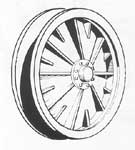 |
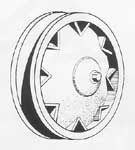 |
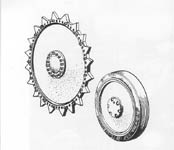 |
Panzer II Ausf.c/A/B/C idler |
Panzer II Ausf.F idler |
Sprocket wheel and road wheel |
| Panzer II - Horst Scheibert, Schiffer Military
History
|
||
Les modèles initiaux étaient équipés du moteur 6 cylindres (essence) Maybach HL 57TR (à refroidissement liquide) développant 130 cv à 2600 tours couplé à une boîte de vitesse ZF Aphon SSG 45 comprenant 6 rapports en marche avant et une marche arrière. Un embrayage à disque et la boîte de vitesse transmettaient la puissance à un arbre transversal dont les extrémités comprenaient un embrayage standard et le mécanisme de freinage et de direction propre à chaque chenille ainsi qu'un barbotin. Dès le modèle c, le moteur sera remplacé par le 6 cylindres (essence) Maybach HL 62 TR (à refroidissement liquide) développant 140 cv à 2600 tours qui deviendra le moteur standard du Panzer II. Ce moteur permettait (cela dépend du blindage des différents modèles) en général une vitesse de pointe sur route de 40 km/h. Le Panzer transportait sauf sur certains modèles 170 l d'essence qui lui permettait une autonomie sur route d'environ 200 km. Les chars qui furent envoyés sur le théâtre africain furent équipés d'un système de ventilation et de filtrage de type Tropisch (Tp) pour climats tropicaux.
The initial models were equipped with the six-cylinder motor (gasoline) Maybach HL 57TR (with liquid cooling) developing 130 hp to 2600 rounds coupled to a gear box ZF Aphon SSG 45 including 6 speess: 5 froward and 1 reverse. A clutch with disc and the gear box transmitted the power to a cross shaft whose ends included a standard clutch and the mechanism of braking and direction specific to each track as well as a sprocket-wheel. As of the model C, the engine will be replaced by the 6 cylinders (gasoline) Maybach HL 62 TR (with liquid cooling) developing 140 hp to 2600 rounds which will become the standard engine of Panzer II. This engine in general allowed (that depends on the shielding of the various models) a maximum speed on road of 40 km/h. Panzer transported except on certain models 170 gasoline L which allowed it an autonomy on road of approximately 200 km. The tanks which were sent on the African theatre were equipped with a system of ventilation and filtering of the type Tropisch (Tp) for tropical climates.
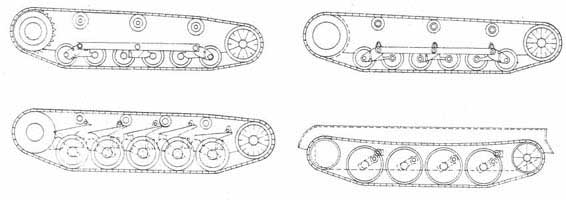 |
Various types of
suspension: Ausf.a - Ausf.b - Ausf.c/A/B/C/F - Ausf.D/E |
src:Connaissance de l'Histoire (Hachette) -
N°17 - " Les chars de combat allemands 39-45"
|
Le Panzer II était à l'origine équipée d'une suspension composé de deux barbotins avant, de deux poulies de tensions dégagées du sol et de deux fois 6 petits galets de roulement (montés par deux sur 6 boggies à ressorts à lames) avec longerons, ainsi que trois rouleaux porteurs. Dès le modèle c la suspension fut modifiée pour comprendre désormais deux fois 5 galets indépendants montés sur ressorts à lames et 4 rouleaux porteurs. Cette suspension deviendra la suspension standard du Panzer II. Certains modèles spéciaux comme les Panzers II Ausf.D/E/G/H/J/M/L furent équipés d'une suspension à barres de torsion comprenant 4-5 axes montés de grands galets imbriqués ou non, sans rouleaux porteurs. Des chenilles de 305 mm furent montés sur le Panzer II bien que les modèles possédant une suspension à galets imbriqués furent équipés de chenilles de 360 mm de large.
Panzer II was in the beginning equipped with a suspension made up of two front sprocket-wheels, two pulleys of tension disengaged from the ground and 12 small road wheels (mounted by two on 6 leaf spring bogie trucks) with members, like three return rollers. As of the model C the suspension was modified to include 5 independent road wheels assembled on leaf springs and 4 return rollers. This suspension will become the standard suspension of Panzer II. Certain special models as Panzers II Ausf.D/E/G/H/J/M/L were equipped with a suspension with torsion bars including 4-5 axes with large road wheels imbricated or not, without return rollers. Tracks of 305 mm were assembled on Panzer II although the models having a suspension with overlapping road wheels were equipped with 360 mm broad tracks.
Sources:
- Connaissance de l'Histoire (Hachette) - HS n°3 - Blindés des origines à 1940
- Connaissance de l'Histoire (Hachette) - N°17 - " Les chars de combat allemands 39-45"
- Connaissance de l'Histoire (Hachette) - N°5 - " Véhicules blindés allemands 39-45"
- Les Blindés de la Seconde Guerre Mondiale (Atlas)
- German light panzers 1932-1942 (Osprey Military) - New Vanguard N°26
- Panzer II - Horst Scheibert, Schiffer Military History
- Site "Achtung Panzer" - http://www.achtungpanzer.com
- Site "Germany's vehicle history" - http://www.wwiivehicles.com
- Site "Second World War Armour" - http://www.onwar.com/tanks/index.htm